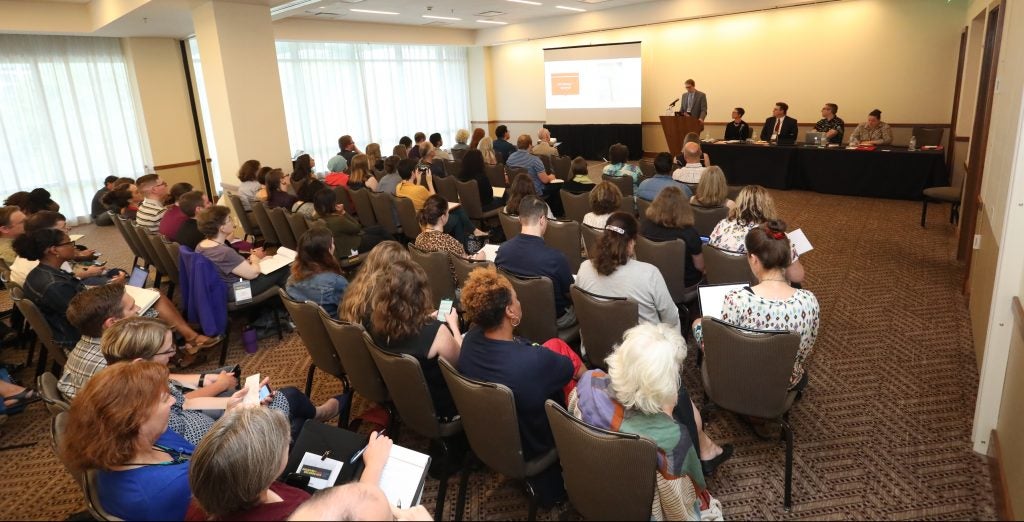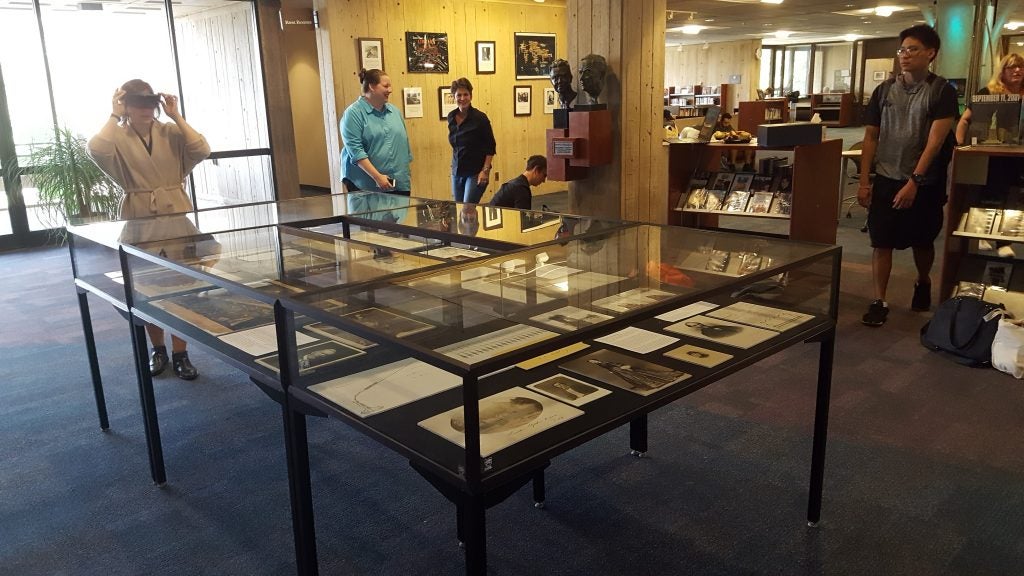
Photograph by Craig Huey
At this year’s national Society of American Archivists (SAA) conference in Austin, Texas, I had the honor of presenting to a crowd of over 100 archivists for a session titled Unboxing the Archives: Transforming Collections with Augmented Reality and Collaborative Design. This session included five speakers from academic, museum, archives, and public library settings. Each speaker gave presentations about their own interdisciplinary collaborations using augmented reality (AR) and/or virtual reality (VR) to share collections with researchers, students, and the public. My presentation, "Augmenting the Archives: Accessing 19th Century Documents through the Lens of 21st Century Technology," focused on a remarkable collaborative endeavor that took place at Rensselaer Libraries in 2017. Though two years have passed since this project took place, it continues to thrive via conversation and throughout the relationships that were forged. This project was a great model for success and made an impact on everyone involved. It fostered deep collaboration, innovation, and storytelling. We paved the way for Rensselaer Libraries and the Institute Archives to engage our communities in unprecedented ways.

Project Scope: Within the course of about eight months in 2017, Library Director Andrew White, Archivist Jenifer Monger, Professor Rebecca Rouse, author Erica Wagner, and junior Noah Zucker (GSAS, Class of 2020), completed "Finding Roebling" a multimodal AR exhibit experience. The project coincided with the release of a new biography, Chief Engineer: Washington Roebling, The Man Who Built The Brooklyn Bridge by Erica Wagner (Bloomsbury).
The author conducted the bulk of her research at Rensselaer’s Institute Archives with material from our extensive Roebling family and Brooklyn Bridge collection. What culminated was an exhibit which showcased manuscripts and artifacts that were augmented with additional imagery, animations, 3D models, and text. One part of the exhibit entitled “Erica’s Desk" simulated Dr. Wagner's research journey using a mobile app. The user accessed AR content tied to each physical object that illustrated Erica's personal research journey. Another part of the exhibit showcased a student's creative development of an exhibit experience using the Microsoft HoloLens which provided mixed reality using smart glasses.
" I first walked across the Brooklyn Bridge probably when I was about 16 years old: although I'd grown up in New York City, I hadn’t done it until then. I was so struck by the bridge- of course that’s not unusual. But I was kind of surprised that I didn’t know anything about it. How it had come to be there, who made it, when it was made? So I started to read about it, and when I did, I encountered the voice of Washington Roebling. It is really true to say that as soon as I started to read anything that he had written, I heard him speaking to me. That's the only way I can put it. It's that which led to this fascination, this obsession..." Erica Wagner

Author, Erica Wagner: Between about 2009 and 2017, author Erica Wagner conducted research in the Rensselaer Institute Archives, using the Roebling Collection to write the first biography of Washington Roebling. She was so invested in telling the story of Washington Roebling and so compelled by her research experience at the Archives she became very excited and eager to go beyond the published book. Erica and I had many long conversations about her research and interest (as well as intrigue) with some key items in the collection. We wanted to create "something," do "something" to honor this magnificent endeavor of hers and I was eager and excited to somehow showcase this collection in a new way. We began brainstorming!
The Roebling Collection: First, I would like our readers to know about one of the Institute Archives' crown jewels: the Roebling collection. This includes the personal and professional papers from members of the Roebling family, the designers and builders of the Brooklyn Bridge which crosses the East River from Brooklyn to Manhattan. Much of the collection documents specifically the design and construction of the Brooklyn Bridge. The collection also reveals who the family was: John A. Roebling, a genius engineer, known for his innovations in suspension bridge construction during the first half of the 19th century; his son Washington Roebling, a Rensselaer graduate from 1857 who became Chief Engineer of the Brooklyn Bridge construction project after his father died of tetanus two weeks before construction began; and Emily Warren Roebling, Washington's wife, best known for carrying out her husband’s construction plans when he was stricken with decompression sickness (the bends) and bed-ridden for much of the construction project. This collection was donated to Rensselaer by Washington's daughter in law, Helen Pierce Roebling in the 1950's.
The family and story of the bridge’s construction has been a beacon call for a plethora of global researchers. David McCullough, author of The Great Bridge (1972), was the first researcher to use this collection extensively. The collection also laid the foundation for Ken Burns' documentary film Brooklyn Bridge (1981), and the BBC's docudrama series for Seven Wonders of the Industrial World (2003).

Photograph by Noah Zucker (Class of 2019)
The Collaboration: Early in 2017, months before Erica Wagner’s biography was released, ideas for an event began to percolate. Rensselaer Professor Rebecca Rouse and I were introduced to one another by Rensselaer’s Library Director who saw the potential to unite us, and we began brainstorming. Rebecca and I dovetailed our expertise; her research focuses on theoretical, critical, and design production work with storytelling for new technologies. She is an expert in the design and development of mixed reality projects. As archivist and curator, my expertise lies in promoting a meaningful exchange between visitors and content, highlighting collections in ways that promote dialogue, new perspectives, and a transformative experience. More importantly, we forged a dynamic relationship with the researcher, Erica Wagner, who was excited to share her research journey and wanted to collaborate with us and bring to life how she came into direct contact with Washington Roebling’s presence by using the Roebling collection in the Institute Archives. Rebecca suggested we hire one of her top students in Games and Simulation Arts and Sciences to add some flair and help us create an exhibit experience that incorporated augmented reality. This was brilliant – since AR allows you to gain real-estate in an exhibit with added design features that overlay digital components onto the physical world. We had a vision, administrative support for our endeavor, we formed a team, and the creativity flowed forth!
"Let the engineers explain the bridge, I want to tell the story of Washington Roebling." Erica Wagner


Concept Design: We based the design and curatorial decisions on Erica’s research, the way she wrote the biography and the story behind her research interests. I began the curatorial process by honing in on content in the Roebling collection that conveyed the life story of Washington Roebling in keeping with how Erica organized her biography. Spread throughout four exhibit cases, content was chosen to tell the story of the student, the son, the chief engineer, and the sick man. Another key component to the exhibit was “Erica’s Desk” where users could handle reproduced objects that were significant to Erica’s research journey in the archives. These objects were enhanced with audio - excerpts from Roebling's memoir and recorded Skype videos of Erica discussing various aspects of her research in conjunction with documents from the collection.

Photograph by Noah Zucker (Class of 2019)
19th Century Documents through the Lens of 21st Century Technology: Noah, our student in Games and Simulation Arts and Sciences got curious once Rebecca and I started providing him content from the Roebling Collection. He wanted to see how creative he could be by using the Microsoft HoloLens device to show another aspect of the exhibit with augmented reality. Noah was interested in the HoloLens because it represents a newer generation of head mounted displays for AR. The attraction is a hands-free AR experience for the user, with the possibility for a wider field of view (as opposed to looking through the frame of your phone.) The HoloLens uses a video projection and mirror refraction system to create the illusion that the AR overlays exist in the plane of space in front of you, outside the headset. Noah was able to choreograph the user to stand back, at a distance from the AR media overlay, so the narrow field of view was not noticed. This had the trade-off of keeping the user away from the cases, as you see in the photograph above. Noah’s work was ingenious in developing a method to keep users unaware of the HoloLens field of view. The head mounted display based AR, however, is still pretty emergent and more experimental — not to mention more expensive. Nevertheless, the exhibit did a great job of straddling both a mobile AR technology as well as the cutting-edge emergent head mounted display based platform!
Our students are encouraged to pursue creativity and discovery. Noah did just that, and used the library space as a laboratory and pushed the boundaries of our interdisciplinary teamwork! You can read more about Noah's work here, where he explains his process and highlights the Microsoft HoloLens project in great detail.

The Finding Roebling Exhibit Today: The exhibit was featured in Folsom Library on the main floor for approximately 10 months (2017-2018). As of today, the reproductions of items in the Roebling collection along with the AR markers used to retrieve the augmentation still exists. The HoloLens portion of the exhibit created by Noah can’t be shown again currently as the software is now outdated. The experience is only available in video capture. This is the reality of a technology heavy exhibit experience. For starters, AR is not yet a "self-sufficient" technology, culturally or technologically, and it's extremely difficult to preserve AR because the platforms change so rapidly. This is precisely the case for the "Finding Roebling" exhibit. This is why we call it an "exhibit experience," something to have been experienced at that time! What remains are numerous photographs that now exist as documentary evidence of this wonderful collaborative project for which I am very thankful to have played a key role in.
Rest assured though, all is not lost! We are considering revamping some portions of the exhibit in the year to come. We will certainly keep the community well informed on our plans.
You Should Know: Commensurate with the opening of the Finding Roebling Exhibit, on September 11, 2017 at the Auditorium, in the Center for Biotechnology & Interdisciplinary Studies, the Third Carl A. Westerdahl Forum featured a dialogue between Jenifer Monger and Erica Wagner, moderated by Andrew White. This video captures the event and will give our readers a sense of the collection's impact, and the relationships that were created in the Archives!
As always, a special thanks!
The Finding Roebling exhibit was made possible by the generosity of the following: Rensselaer Alumni Association, Friends of Folsom Library, Rensselaer County Historical Society, Husdon Mohawk Gateway, and the School of Humanities, Arts and Social Sciences.
Our Core Collaborative Team: Andrew White: Director of Rensselaer Libraries (Exhibit Producer); Jenifer Monger: Assistant Institute Archivist (Exhibit Designer); Erica Wagner: Author, Chief Engineer: Washington Roebling, The Man Who Built the Brooklyn Bridge; Rebecca Rouse: Assistant Professor of Arts (Experience Designer); Noah Zucker: GSAS '19 (Lead Developer and Interface Designer); Marc Destefano: Senior Lecturer of Cognitive Science (Voice Actor)
